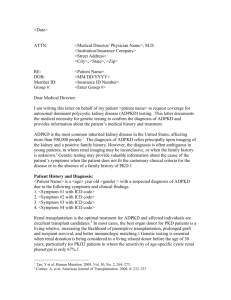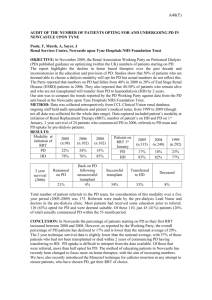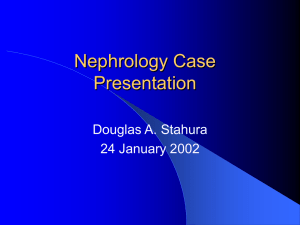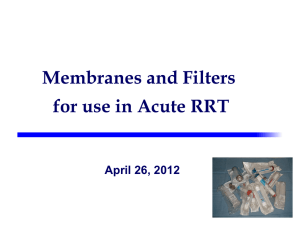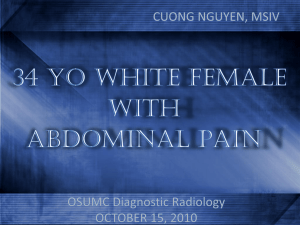B- CRF : measurement of renal function C
advertisement
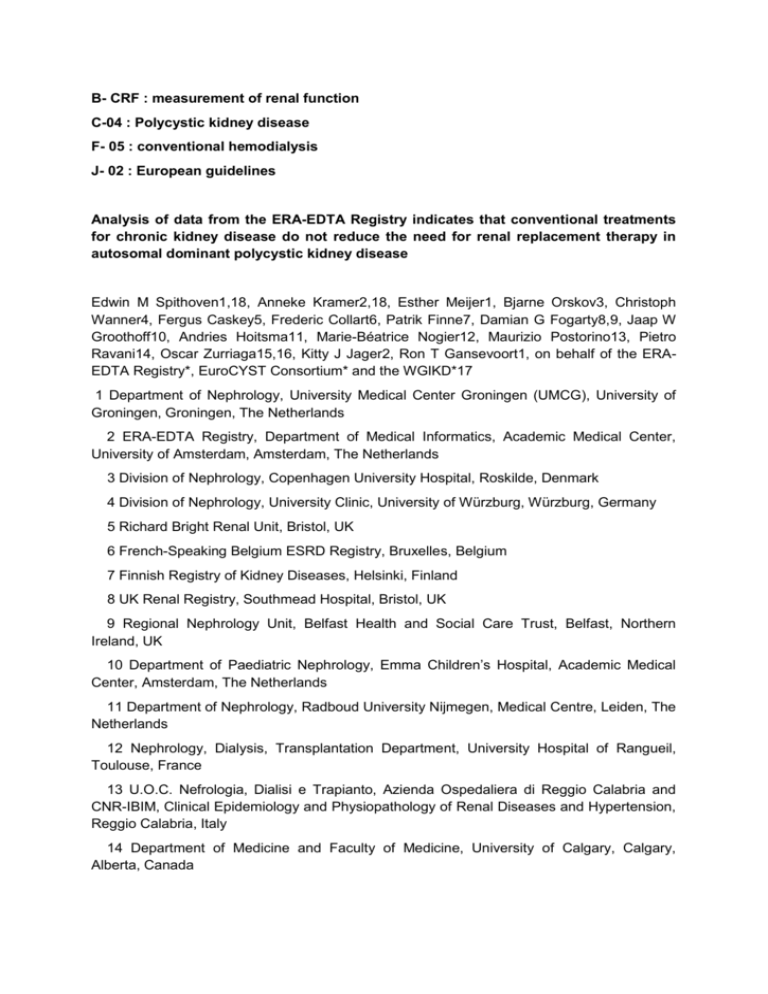
B- CRF : measurement of renal function C-04 : Polycystic kidney disease F- 05 : conventional hemodialysis J- 02 : European guidelines Analysis of data from the ERA-EDTA Registry indicates that conventional treatments for chronic kidney disease do not reduce the need for renal replacement therapy in autosomal dominant polycystic kidney disease Edwin M Spithoven1,18, Anneke Kramer2,18, Esther Meijer1, Bjarne Orskov3, Christoph Wanner4, Fergus Caskey5, Frederic Collart6, Patrik Finne7, Damian G Fogarty8,9, Jaap W Groothoff10, Andries Hoitsma11, Marie-Béatrice Nogier12, Maurizio Postorino13, Pietro Ravani14, Oscar Zurriaga15,16, Kitty J Jager2, Ron T Gansevoort1, on behalf of the ERAEDTA Registry*, EuroCYST Consortium* and the WGIKD*17 1 Department of Nephrology, University Medical Center Groningen (UMCG), University of Groningen, Groningen, The Netherlands 2 ERA-EDTA Registry, Department of Medical Informatics, Academic Medical Center, University of Amsterdam, Amsterdam, The Netherlands 3 Division of Nephrology, Copenhagen University Hospital, Roskilde, Denmark 4 Division of Nephrology, University Clinic, University of Würzburg, Würzburg, Germany 5 Richard Bright Renal Unit, Bristol, UK 6 French-Speaking Belgium ESRD Registry, Bruxelles, Belgium 7 Finnish Registry of Kidney Diseases, Helsinki, Finland 8 UK Renal Registry, Southmead Hospital, Bristol, UK 9 Regional Nephrology Unit, Belfast Health and Social Care Trust, Belfast, Northern Ireland, UK 10 Department of Paediatric Nephrology, Emma Children’s Hospital, Academic Medical Center, Amsterdam, The Netherlands 11 Department of Nephrology, Radboud University Nijmegen, Medical Centre, Leiden, The Netherlands 12 Nephrology, Dialysis, Transplantation Department, University Hospital of Rangueil, Toulouse, France 13 U.O.C. Nefrologia, Dialisi e Trapianto, Azienda Ospedaliera di Reggio Calabria and CNR-IBIM, Clinical Epidemiology and Physiopathology of Renal Diseases and Hypertension, Reggio Calabria, Italy 14 Department of Medicine and Faculty of Medicine, University of Calgary, Calgary, Alberta, Canada 15 Subirección General de Epidemiología y Vigilancia de la Salud. Conselleria de Sanitat. Generalitat C, Valenciana, Spain 16 Spanish Consortium of Epidemiology and Public Health Research (CIBERESP) Correspondence: Ron T. Gansevoort, Department of Nephrology, University Medical Center Groningen (UMCG), University of Groningen, PO Box 30.001, 9700 RB Groningen, The Netherlands. E-mail: R.T.Gansevoort@umcg.nl Journal : Kidney International Year : 2014 Volume : 86 Pages : 1244–1252 ABSTRACT Autosomal dominant polycystic kidney disease (ADPKD) is a major cause of end-stage kidney failure, but is often identified early and therefore amenable to timely treatment. Interventions known to postpone the need for renal replacement therapy (RRT) in nonADPKD patients have also been tested in ADPKD patients, but with inconclusive results. To help resolve this we determined changes in RRT incidence rates as an indicator for increasing effective renoprotection over time in ADPKD. We analyzed data from the European Renal Association-European Dialyses and Transplant Association Registry on 315,444 patients starting RRT in 12 European countries between 1991 and 2010, grouped into four 5-year periods. Of them, 20,596 were due to ADPKD. Between the first and last period the mean age at onset of RRT increased from 56.6 to 58.0 years. The age- and gender-adjusted incidence rate of RRT for ADPKD increased slightly over the four periods from 7.6 to 8.3 per million population. No change over time was found in the incidence of RRT for ADPKD up to age 50, whereas in recent time periods the incidence in patients above the age of 70 clearly increased. Among countries there was a significant positive association between RRT take-on rates for non-ADPKD kidney disease and ADPKD. Thus, the increased age at onset of RRT is most likely due to an increased access for elderly ADPKD patients or lower competing risk prior to the start of RRT rather than the consequence of effective emerging renoprotective treatments for ADPKD. Keywords: ADPKD; epidemiology; renoprotective therapy COMMENTS Autosomal dominant polycystic kidney disease (ADPKD) is the most common heritable kidney disease, affecting ~1 in every 1000 subjects Most affected subjects show progressive renal function decline and need renal replacement therapy (RRT) between their 40th and 70th year of age. Over the past decades several treatment options have emerged to postpone the need for RRT in subjects with chronic kidney disease, such as strict blood pressure control, renin– angiotensin–aldosterone system inhibition, and low-protein diets. The hypothesis of this study was that, with a stable prevalence of ADPKD in the general population, changes in the incidence rate of RRT may provide indications whether renoprotective treatments have emerged for ADPKD during the last two decades. Between 1991 and 2010 a total of 314,176 patients from 12 countries started RRT; of them, 20,483 had ADPKD as the cause of kidney failure and 293,693 patients had other kidney diseases. An overall 54% of ADPKD patients and 62% of non-ADPKD patients were male. Over this time period the crude incidence rate of RRT for ADPKD increased from 6.9 to 8.4 per million population (p.m.p.). The average age- and gender-adjusted incidence rate has increased by 9.2% from 7.6 p.m.p. in 1991–1995 to 8.3 p.m.p. in 2006–2010 This study shows that the incidence rate of RRT and the age at onset of RRT for ADPKD have increased slightly. Importantly, for ADPKD patients up to 50 years of age the RRT incidence rate expressed per million of the age-related population has remained stable, whereas at older age an increase was observed. Furthermore, a positive association was found between the RRT incidence rate for ADPKD and that for non-ADPKD patients. The authors interpret these findings as being due to more number of elderly patients having been selected to start RRT or to a decrease in mortality of older patients before reaching ESRD rather than as effective renoprotective treatments having emerged for ADPKD. However this retrospective study has not evaluated the present ongoing studies dealing with treatments such as ligands of the AVP receptor or sirolimus prescribed for postponing endstage renal failure and the start of dialysis in patients with PKD. Pr. Jacques CHANARD Professor of Nephrology
